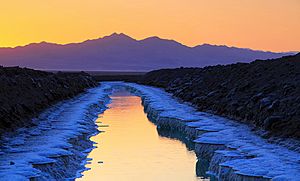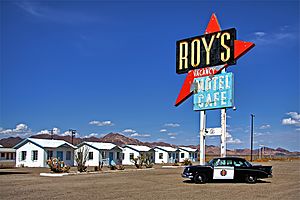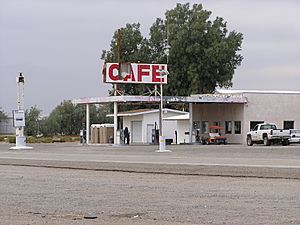Amboy, California facts for kids
Quick facts for kids
Amboy, California
|
|
|---|---|
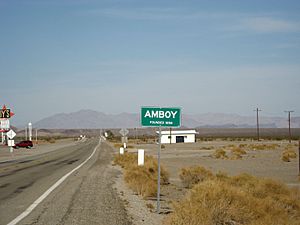
Amboy sign, west side of town
|
|
| Country | United States |
| State | California |
| County | San Bernardino |
| Founded | 1883 |
| Population
(2010)
|
|
| • Total | 4 |
| Time zone | UTC-8 (Pacific (PST)) |
| • Summer (DST) | UTC-7 (PDT) |
| ZIP codes |
92304
|
| Area codes | 442/760 |
| GNIS feature ID | 238579 |
Amboy is a small, quiet place in the Mojave Desert in San Bernardino County, California. It's located on the famous historic Route 66, between Needles and Ludlow. Amboy is about 60 miles (97 km) northeast of Twentynine Palms.
In 2020, Amboy had a post office, a historic motel, and a Route 66 tourist shop. Only four people lived there and ran these businesses. By 2024, only the gas station was open, and the town's population was zero.
Contents
History of Amboy
Amboy was first settled in 1858, but it officially became a town in 1883. Lewis Kingman, an engineer for the Atlantic and Pacific Railroad, helped create Amboy. It was the first of many railroad stations built in alphabetical order across the Mojave Desert. The town's name likely came from a place in the eastern United States.
In 1926, Amboy became a very busy place when U.S. Route 66 opened. This famous road brought many travelers through the town.
Roy's Motel and Café Opens
In 1938, Roy's Motel and Café opened. It became very popular because it was one of the few places to stop on the long, isolated road. By 1940, Amboy's population grew to 65 people. Its growth was not just from tourists, but also from the Santa Fe Railroad. Freight trains still use these tracks today.
During the Great Depression and World War II (1929-1945), fewer people traveled. However, those who did still needed places to stay, eat, and get gas. This kept Amboy busy. The town stayed active until 1973, when Interstate 40 opened. This new highway bypassed Amboy, meaning travelers no longer drove through the town.
By 2024, news reports said that Amboy had no permanent residents. Even so, one business remained open, keeping it from becoming a complete ghost town.
Where is Amboy Located?
Amboy is located south of the Granite Mountains, Providence Mountains, and the Mojave National Preserve. To the south, you can see the famous Amboy Crater. Beyond that are the Bullion Mountains. To the south is Bristol Dry Lake and the small community of Cadiz, California.
Amboy was once a very important stop on Route 66. However, since Interstate 40 opened in 1973, fewer people visit. Amboy is still home to Roy's Motel and Café, which is a well-known landmark on Route 66.
In 2007, Amboy reportedly had only 10 buildings left and a population of about four people. A documentary in 2014 also stated the population was four men. By 2024, the number of permanent residents dropped to zero. Only one business staying open prevents Amboy from being called a true ghost town.
Roy's Motel and Café
Roy's Motel and Café used to offer gas, food, and places to sleep. It is famous for its unique "retro-future" style of architecture, called Googie style. The iconic sign was added in 1959.
Buster Burris, a famous character from Route 66, once owned Roy's and the entire town. He bought Roy's from his father-in-law, Roy Crowl, in 1938. Roy Crowl was the person the property was named after. Buster ran the town until 1995.
The Growth of Roy's
In 1938, Roy Crowl opened "Roy's" as a gas station on Route 66. Roy and his wife, Velma, owned the town. In the 1940s, Roy partnered with Herman "Buster" Burris, who married Roy's daughter, Betty. Together, they made the business bigger. They kept it open 24 hours a day and added a motel to the gas station and café. Business boomed after World War II because so many people were traveling by car.
The old National Trails Highway (1914) and later Route 66 passed through Amboy. This brought a lot of business, especially to Roy's. The place was so busy in the summer that Buster Burris even placed ads in other states to find employees.
New Owners and Restoration
Buster sold the town in 1995 and moved away. The town was then owned by investors Walt Wilson and Tim White. They mostly used it for photo shoots and movie filming. After they lost the property, Buster's widow, Bessie Burris, got it back.
In February 2005, Bessie sold the property to Albert Okura, who owns the Juan Pollo restaurant chain. He paid $425,000 in cash. Albert promised to take care of the town and reopen Roy's. The deal included about 490 acres, which was the town itself. It also included Roy's Motel and Café, the church, post office, gas pumps, and other buildings. Okura also planned to open a museum, similar to how he turned the original McDonald's location in San Bernardino into a museum.
Albert Okura wanted to restore the town for Route 66 tourists. He saw buying the town as part of his "destiny." On April 28, 2008, Roy's gas station reopened after $100,000 in repairs. Albert Okura also planned to open a café and mini-mart. However, the restaurant remained closed because there wasn't enough clean water. By 2015, the motel was also closed. A gift shop is now open in the café, and you can get gas if you ask. The motel has also been used for art shows. Albert Okura passed away in 2023, and his son, Kyle, is continuing his efforts to save Amboy.
Roy's has attracted some famous visitors. Actors Harrison Ford and Anthony Hopkins have signed photos on the restaurant walls. They visit whenever they can. Harrison Ford often flies his plane in and lands it on a nearby airstrip, which was one of the first ever built in California.
Amboy School
The old Amboy School is next to Roy's. The school closed in 1999 because the last students moved away from the town.
Amboy in Movies and TV
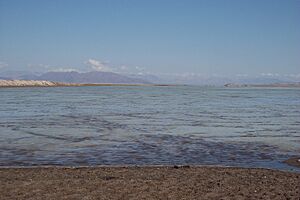
Amboy has been featured in several movies and TV shows.
- Part of the 1986 film The Hitcher was filmed in Amboy.
- Roy's was used for a 1999 TV commercial for Qwest Communications.
- It also appeared in Enrique Iglesias' music video "Hero" and the film Live Evil.
- The town's former owners kept Amboy looking old and weathered so it could be used as a movie set.
In 1993, Huell Howser visited Amboy for his show California's Gold. He interviewed Buster Burris, the owner of Roy's, and showed the Amboy Crater.
Amboy in Popular Culture
- A fictional version of Amboy, including Roy's Hotel and its sign, was part of a map in the game 18 Wheels of Steel Haulin.
- The racing game Blur (2010) features Amboy in some of its tracks.
- The heist film "They Came To Rob Las Vegas" (1968) takes place near Amboy in the desert.
See also
 In Spanish: Amboy (California) para niños
In Spanish: Amboy (California) para niños



